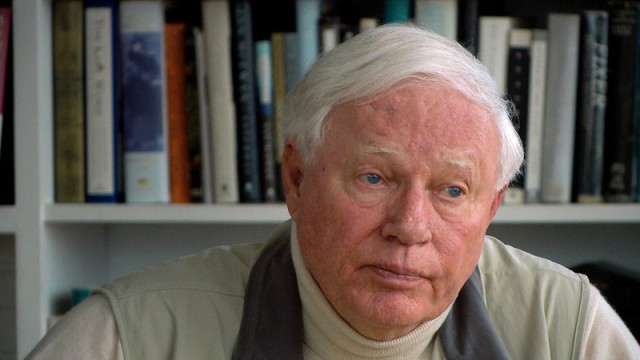 DR. JOHN STEELE IN THE ILLNESS AND THE ODYSSEYTracing a frustrating search for the cause of a major cause of death
DR. JOHN STEELE IN THE ILLNESS AND THE ODYSSEYTracing a frustrating search for the cause of a major cause of death One in four people die of a neurodegenerative disease, Berry Winott's straightforward documentary documentary tells us. The focus is on the Chamorro people on the island of Guam, particularly the inhabitants of the town of Umatac. Since the Fifties they've been studied, because they have had a very high proportion of their population dying of a neurodegeneratie disease, related to Parkinson's, Alzheimer's, and ALS (Lou Gehrig's Disease), which is called lytigo-bodig disease. There's no answer here. This is just a story of a sequence of theories that have one by one not borne fruit, and the controversy in the scientific community surrounding them. Various scientists, such as Dr. John Steele and Dr. Peter Spencer and their friend Oliver Sacks, narrate much of the story, with contributions from Jonathan Weiner, the science writer. There are several others. This is a clear and interesting little documentary, not very sexy, but perhaps all the better for not leading to a happy conclusion. Scientific research is often a long and frustrating process, with many false starts and wrong turns before a solution is found.
The Illness and the Odyssey shows us that.
First came the idea that since lytigo-bodig was inflicting families very heavily, its origins were genetic. But this was discarded when people who came to Guam later from other locations also died of lytigo-bodig. Next came the neurotoxin theory, because the Chamorros consume pastries made from flour made from cycads, a nut that contains the toxin called BMAA. Dr. Peter Spencer, a neurotoxicologist, worked on this possibility, and BMAA was found, through help from Miami University Brain Endowment Bank director Deborah Mash. This hypothesis was rejected for several reasons. The primate testing showed neurodegenerative disease symptoms right away, but the quantity administered was enormous. Whether small quantities over time would cause them was not shown, but long term primate testing was not possible.
Dr. Steele moved onto a parasite theory based on the finding of retinal neuropathy in lytigo-bodig patients. Then along came Paul Cox, an ethnobotonist, with his bat theory, quickly dubbed, Oliver Sacks notes, as the "batty" theory. This was the theory that since the Chamorros consumed whole Pacific fruit bats in soup, they might ingest neurotoxins that way. The hypothesis at least was that the flesh of the fruit bats might contain a huge concentration of BMAA, far more than would come through cycads.
A further issue was that two nearby areas, in Japan and West Papua, New Guinea, with a considerable amount of neurodegenerative disease did or did not have cycads, and first a scientist researching this found there were no cycads in Japan, and then more recently it was found that in fact there definitely were. As often with intense searches for the sources of diseases, involving dynamic and volatile individuals, competition throughout all this was intense, with much debunking of rival theories. One of the speakers based on Guam is extremely negative in his comments on the National Institutes of Health, whose researchers were want to bypass him and his colleagues and claim that the lytigo-bodig research belonged to the NIH, and to nobody else. And so on. A pungent observer on the changing theories and the controversies is Dr. Kwang-Ming Chen, naurologist who moved to Guam in the Sixties, and worked with Nobel Prize winner Dr. Carleton Gajdusek, who worked on prions, rogue proteins that cause, among other things, mad cow disease. Gajdusek thought lytigo-bodeg was an infectious disease, not caused by toxins. After 20 years, he decided lytigo-bodeg was not a prion disease but, rejecting cycads, focused on toxins in the water, especially aluminum. That didn't pan out either. Dr. John Steele, who came to Guam in the Sixties, disproved it. Oliver Sacks came and made house calls with Dr. Steele and wrote a book about Guam. Dr. Spencer came, and returned to the cycad hypothesis.
Another occasional commentator is Dr. Walter Bradley, emeritus chairman of Miami University's Department of Neurology and author of
Treating the Brain.
A further development was the realization that the BMAA in cycads is not generated by the cycads themselves but via algae that attach themselves to them -- algae similar to algae found virtually everywhere, and increasing in concentration due to global warming.
Jonathan Weiner's article,
"Tangles", from 2005, focused on Paul Cox's work, led to a lot of interest in lytigo-bodig. Weiner speaks of the personal aspect of the story -- a close relative was suffering from a neurodegenerative disease as he wrote -- and the unresolved and controversial nature of all the Guam research, particularly the energetic, charismatic Cox's "batty" theory.
It was hopeful that since the Nineties the role of lytigo-bodig in the deaths of the people of Guam has dropped markedly. Nobody knows why, but it shows that the incidence of neurodegenerative disease can drop.
The search for a solution to the problem of neurodegenerative disease goes on, and the focus on Guam has by no means been abandoned. The latest is that researchers from the University of California San Francisco will be coming to Guam next year to conduct more research with 20 residents of Umatac.
The Illness and the Odyssey, 70 mins., debuted October 5, 23013 at Mill Valley. It was screened for this review as part of the San Francisco Film Society's Cinema by the Bay series, where it was shown Sunday, November 24, 7:00 pm, at the Roxie Theater.





